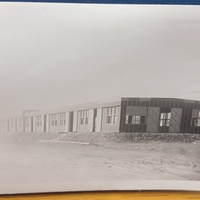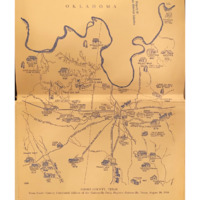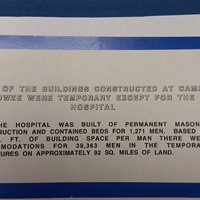The Land and Foundation of Camp Howze
Before Camp Howze came to fruition, it required space and land for construction. In 1940, the War Department queried the people of Gainesville via questionnaire as to whether they would be willing to support a military training camp in their city. Citizens wholeheartedly welcomed the idea of a transitional military camp that would train soldiers for overseas assignments. One of the best contributions Gainesville gave to the war effort on the home front, was its rich and fertile land. Approximately 59,000 acres of undulating topographical ranges and hilly prairie land in northeast Texas would be chosen as the location for Camp Howze. The land was loaded with potential to house enlisted, officers and some civilians. Camp Howze had one of the largest laundry facilities at the time and the equipment cost one million dollars. The land, once ideal for agriculture and grazing, would eventually be permanently changed through constant military training to include mortar, small arms, hand grenades, reconnaissance and vehicle manuevers.
During construction of the camp, military assisted with transportation and placement of lumber for temporary barracks and buildings. Enlisted barracks were made of basic wood and covered with tar paper. A coal furnace was placed at opposite ends of the building that housed forty soldiers. The barracks was either too hot or too cold and rarely was the furnace sufficient to adequately heat the makeshift building. It was war time and sacrifices were made.
The camp was a city within a city. Buses transported soldiers to Denton, Dallas or Fort Worth. Some soldiers paid five dollars one way to hitch a ride in the back of a pickup truck to Dallas. Although the camaraderie in the military added to esprit de corps, few are the soldiers who refused a ride out of Camp Howze for rest, recreation, dancing and socializing with Texans.
The foundational posts were composed of heavy cement and along with a portion of the camp hospital are visible to date. After the war, it was cost effective and easier to leave the posts in place. A hospital corridor and remnants remained because it was constructed with permanent masonry. In 1889, a historical booklet about Gainesville boasted of the rich black loam and deep red clay that made Texas irresistible to "good citizens" who wanted growth, development and businesses in Gainesville. During the Second World War, the Gainesville community gave their greatest treasures, their sons and land, in unanimous unselfish support of America and the Allies on the front lines overseas.
During the war, temporary military training installations were rapidly constructed all over Texas cities and included Pampa, Hondo, Midland, and Marfa. In Gainesville, civilians at Camp Howze worked almost nonstop in preparation for incoming military personnel. Approximately ninety acres of land served as foundation for assorted camp buildings. Other land was utilized for ongoing training, surveillance, reconnaissance, marching, other military exercises and most probably, to set up a bivouac near the lake. The main surface water body on site was Moss Lake. North and South Fish Creek fed approximately 1, 125 acres of the lake. Vegetation at Camp Howze was varied and oak forested areas, riverine wooded and upland grassy plains provided excellent training locations for Camp Howze soldiers. Bald eagles nested and fed within the former camp boundaries. According to staff at Morton Museum in Gainesville, there are probable Indian mounds and burial grounds closer to the Texas/Oklahoma border. Specific Native American tribes have not been identified with any mounds or artifacts to date. The Gainesville community on the Texas home front willingly offered their land so that soldiers from other states would be prepared for what awaited them overseas. The capricious Texas climate and rugged terrain taught essential survival skills to Camp Howze soldiers. The stars at night in Gainesville must have dazzled the soldiers from the north. The people of Gainesville collected scrap metal, rubber, rationed food and gas. They limited their intake of caffeine and sugar so that soldiers overseas would not start their day without coffee. They planted victory gardens. The Gainesville community with grateful hearts, united and made important contributions to the war effort because they were fighting for victory too. In wartime, when the patriotic citizens of Gainesville looked up into the Texas sky at night, they sent love and prayers to their relatives, friends, and Camp Howze soldiers who left their imprint on the land that nourished, molded and trained them.











